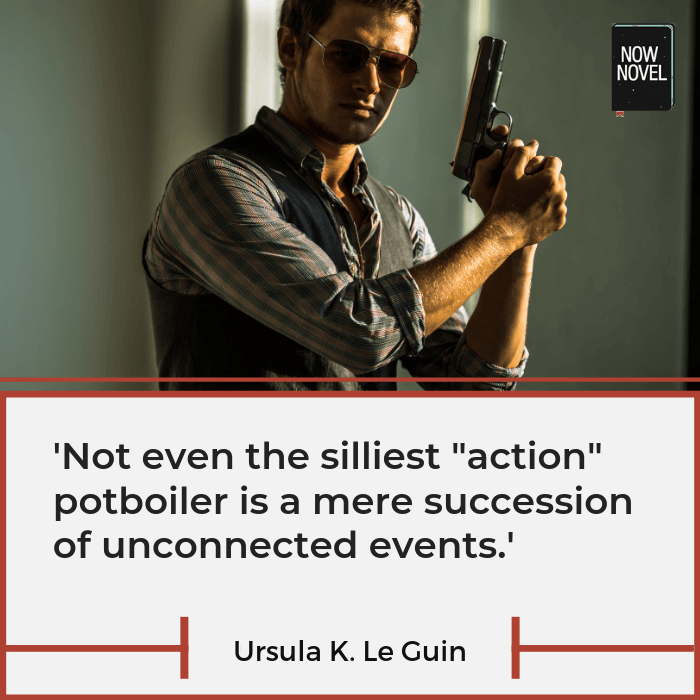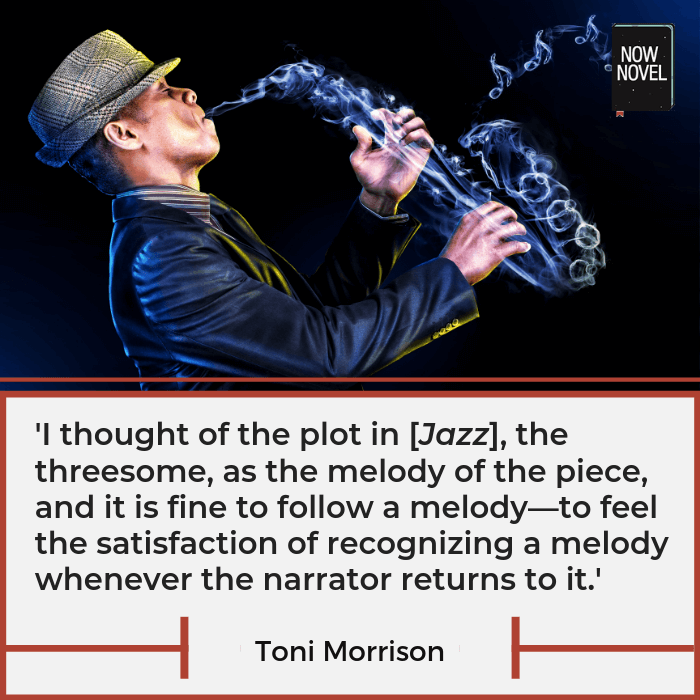Many authors have shared interesting plot ideas, giving insights on how plot works and why it matters. Here are 6 authors’ ideas from essays and interviews about plot, and what they teach us:
1. Find the cause and effect between events
Defining plot, E.M. Forster gives us the classic quote:
A plot is also a narrative of events, the emphasis falling on causality. ‘The king died and then the queen died’ is a story. ‘The king died, and then the queen died of grief’ is a plot. The time-sequence is preserved, but the sense of causality overshadows it.
E.M. Forster, Aspects of the Novel, 1927.
What Forster means is that plot lies in the ‘why’ connecting events. Why does this event (such as the queen’s death) follow another?
To Forster, answering that simple question ‘why’ (or delaying an answer by creating mystery) is what plot does.
A useful exercise when you plot a story is to come up with a selection of isolated plot events, then imagine possible links between them. [This is a key group of steps in the Core Plot section of our story outlining tool.]
For example, you could write out several event summaries like this:
- A woman goes missing
- A stranger comes to town
- A married couple (the missing woman’s sister and brother-in-law) have trouble in their marriage
Try to brainstorm links. For example:
The stranger comes to town because the woman goes missing. (He’s the detective assigned to the case.)
The couple argues because the husband mistrusts the detective’s character or motivations (or seems to).
This process of connecting events adheres to another popular piece of advice from Forster: ‘Only connect’.
2. Elaborate on story events (but keep your story coherent)
Ursula K. Le Guin quotes Forster’s plot definition and argues with it in her essay ‘The Narrative Gift as a Moral Conundrum’. She shares her own interesting plot ideas:
I honor E.M. Forster, but I don’t believe [story is just unconnected ‘this happens, then that’]. Children often tell “this happened and then this happened,” and so do people naively recounting their dream or a movie, but in literature, story in Forster’s sense doesn’t exist. Not even the silliest “action” potboiler is a mere succession of unconnected events.
Ursula K. Le Guin, ‘The Narrative Gift as a Moral Conundrum’ in No Time to Spare (2017), p. 75.
Le Guin explains her view of what makes plot interesting further:
I have a high opinion of story. I see it as the essential trajectory of narrative: a coherent, onward movement, taking the reader from Here to There. Plot, to me, is variation or complication of the movement of story.
Le Guin, p. 75.
Story goes. Plot elaborates the going.

What makes Le Guin’s view of plot interesting?
This idea of plot as elaboration of moving, changing events allows many more kinds of stories. For example, a mysterious story where the meaning behind events isn’t explained (like in David Lynch’s film-making style, which has earned its own adjective ‘Lynchian’ for its dream-like ‘this happened, then that’ structure).
In some stories, as Le Guin suggests, the joy of reading comes from the journey (the going ‘from here to there’) rather than cause and effect being neatly explained, wrapped up in a bow. The reader more explicitly is required to find their own, personal meaning in the process of reading.
Yet Le Guin uses an important word in this argument: ‘coherent’, meaning ‘forming a unified whole’.
If you don’t give your reader all the answers to why things happen in the course of your story’s ‘here to there’, make sure there is some kind of running thread, at least. Themes, images, symbols, characters, mood and tone – tie everything together sufficiently for your story not to read as random events with no connection between them whatsoever.
3. Balance plotting ahead and discovering as you go
Although we’re advocates of outlining (because planning helps you avoid getting stuck), J.K. Rowling shared this idea on plotting in an interview for Scholastic:
‘I always have a basic plot outline, but I like to leave some things to be decided while I write. It’s more fun.’
J.K. Rowling interview with Scholastic, full interview available here.
You may prefer to outline in detail and create character profiles, summaries of all your major plot points, and scene and setting summaries.
Or you may prefer to move back and forth between outlining some elements of plot upfront and leaving the rest to a process of discovery.
4. Let characters’ desires and goals drive plot
The author of Fahrenheit 451 Ray Bradbury had this to say about plot:
‘Remember: Plot is no more than footprints left in the snow after your characters have run by on their way to incredible destinations. Plot is observed after the fact rather than before. It cannot precede action. It is the chart that remains when an actionis through. That is all Plot ever should be. It is human desire letrun, running, and reaching a goal. It cannot be mechanical.’
Ray Bradbury, Zen in the Art of Writing (1990), p. 130.
What Bradbury suggests here is that plot is an after-effect of taking characters’ arcs to their conclusions. He advocates giving characters personalities, goals, desires, motivations and situations to respond to and letting plot arise organically out of how these multiple facets shape events’ unfolding.
As an exercise, take a plot prompt, such as this one from our list of 50 writing prompts:
A character arrives late to a party, not knowing that an old significant other is attending too. The relationship didn’t end well. The host introduces them to each other, unaware of their history.
Brainstorm two character profiles for the exes described in this prompt.
Give each character flaws, desires, fears and other distinguishing traits. [You can brainstorm these elements in the character profiling tool in the Now Novel dashboard.]
Now try to write a few paragraphs of this scene. How do the personality details you’ve imagined shift or shape this unexpected encounter?
5. Find a voice and let plot flow from that
Author Martin Amis shared an interesting view on plot with Francesca Riviere in the Spring 1998 issue of The Paris Review. When Riviere asked him, ‘How important is plot to you?’ he replied:
‘Plots really matter only in thrillers. In mainstream writing the plot is—what is it? A hook. The reader is going to wonder how things turn out. In this respect, Money was a much more difficult book to write than London Fields because it is essentially a plotless novel. It is what I would call a voice novel. If the voice doesn’t work you’re screwed.’
Martin Amis interviewed by Francesca Riviere in ‘Martin Amis, The Art of Fiction no. 151’, available here.
Think of beloved novels such as J.D. Salinger’s Catcher in the Rye or Toni Morrison’s Sula. What many of the books that have made it into ‘classic’ status have in common is a strong narrative voice. A whole plot – which is to say nuances and complications of story – can grow from just imagining the world from the perspective of an interesting voice.
When Holden Caulfield in Salinger’s novel describes the time of year in the story’s opening pages, we can hear his disaffected, cynical, teenage voice:
Anyway, it was December and all, and it was cold as a witch’s teat, especially on top of that stupid hill.
J.D. Salinger, Catcher in the Rye (1951), p. 3
What is your viewpoint character’s outlook (the person telling the story)? Are they sunny and optimistic or more jaded and cynical like Holden?
Finding the voice that tells your story is helpful, in much the same way as finding a character’s voice is helpful to an actor. Once they have the voice down, they can improvise scenes and scenarios, more easily creating the events that make up a plot.
6. Play with how and when you reveal key events
Elsewhere in Ursula K. Le Guin’s critique of E.M. Forster’s idea of plot discussed above, she describes some of the ways plot moves and works in a story, giving different authors’ use of plot as examples:
Plot hesitates, pauses, doubles back (Proust), forecasts, leaps, doubling or tripling simultaneous trajectories (Dickens), diagrams a geometry onto the story line (Hardy), makes the story Ariadne’s string leading through a labyrinth (mysteries)…
Le Guin, p. 75.
What Le Guin suggests about interesting plot ideas is it’s not the idea as much as the way it unfolds, multiplies, comes together, that makes it interesting.
Toni Morrison shares a similar view in her interview for The Paris Review, where she describes creating the plot for her novel Jazz in musical terms:
In Jazz, just as I did before with The Bluest Eye, I put the whole plot on the first page. In fact, in the first edition the plot was on the cover, so that a person in a bookstore could read the cover and know right away what the book was about, and could, if they wished, dismiss it and buy another book.
This seemed a suitable technique for Jazz because I thought of the plot in that novel, the threesome, as the melody of the piece, and it is fine to follow a melody—to feel the satisfaction of recognizing a melody whenever the narrator returns to it. That was the real art of the enterprise for me—bumping up against that melody time and again, seeing it from another point of view, seeing it afresh each time, playing it back and forth.
Toni Morrison, interviewed by Elissa Schappell in ‘The Art of Fiction No. 134’, available here.

The way Morrison describes plot in Jazz, it isn’t so much a linear progression as a motif the narrator returns to (like the theme in a piece of music), examining it from different angles.
As the above 6 authors’ insights show, there are many creative ways to find and develop interesting plot ideas. Develop yours now with helpful writing prompts or one-on-one guidance from an experienced editor.

